Apple HomePod versus Sonos & Ikea Symfonisk smart speakers
After we published our reviews of the Ikea Symfonisk line, we got asked to directly compare the product to Apple's HomePod. So, let's do it.
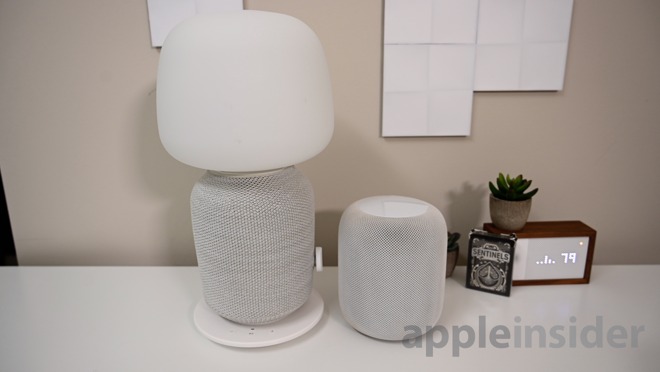
Apple HomePod and the Ikea Symfonisk lamp speaker
The body of the Ikea Symfonisk is just slightly larger before you get to the lamp and base. While the HomePod is smaller, it is also a dedicated device so the Symfonisk may be preferred as it can also replace a lamp at the same time.
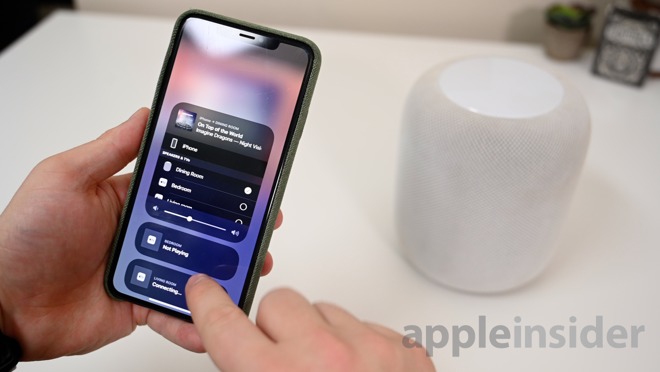
AirPlay 2 works with both speakers
For Apple users, both devices rely heavily on AirPlay 2, natively support Apple Music, and can be configured in a stereo pair.
They also each can be automatically tuned to fit the space, though through different means. The HomePod uses an internal array of microphones and accelerometers to automatically tune itself whenever moved and the Symfonisk lamp uses Truetune from the Sonos app on an iPhone.
Neither work over Bluetooth.
The HomePod is hefty and more compact than the Symfonisk Lamp, and sends audio out in all directions. The only physical controls are located on top in the form of a simple touch-sensitive screen.
There are microphones internally which are used not just for tuning, but for conversing with Siri and taking phone calls. If you are looking for a speaker with a virtual assistant, then this is your option as Symfonisk has no assistant whatsoever.
In the fall of 2019, iOS 13 and the updated HomePod software will bring even more features. That includes multi-user support for up to six people and Handoff support that allows phone calls and audio to instantly transfer between the HomePod and your phone with a tap.
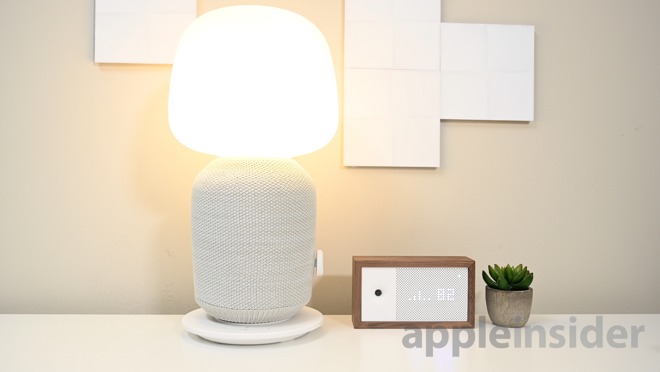
Ikea + Symfonisk lamp speaker
For privacy-minded individuals, the lack of any sort of microphone is a huge benefit. It also has an Ethernet port around back so it doesn't have to rely on the wireless network.
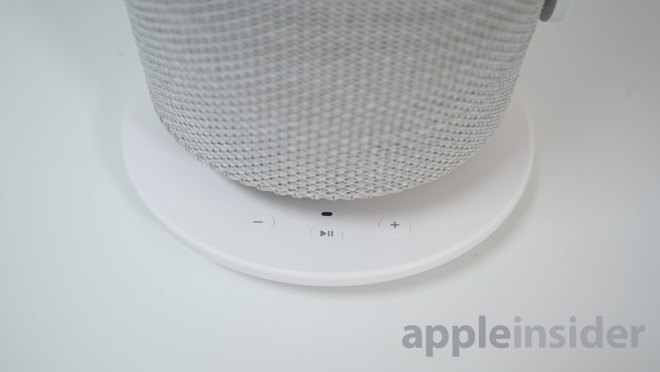
Ikea + Symfonisk lamp speaker control buttons
On the front are simple physical buttons that make the Symfonisk Lamp easy to control without a series of taps. Plus, instead of just acting as a stereo pair, Ikea's Symfonisk Lamp can also be configured to act as rear satellite surround speakers for any Sonos soundbar.
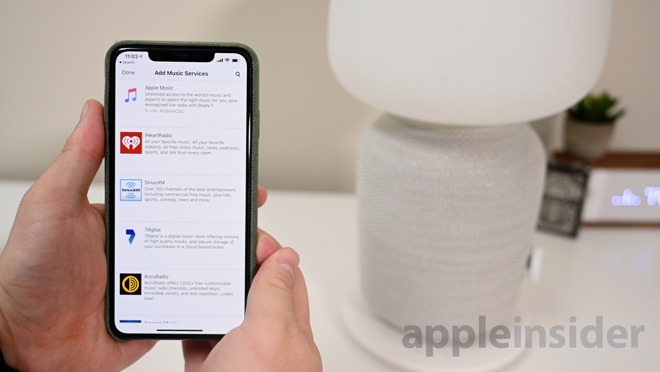
Ikea + Symfonisk lamp speaker supports many Sonos streaming services
The Symfonisk Lamp isn't limited to just AirPlay 2 and Apple Music. There are dozens of other sources that can be triggered by the Sonos app, and streamed natively by the speaker's hardware including Spotify, Pandora, Sirius XM, Tidal, and many more. If you don't use Apple Music, this is a huge benefit.
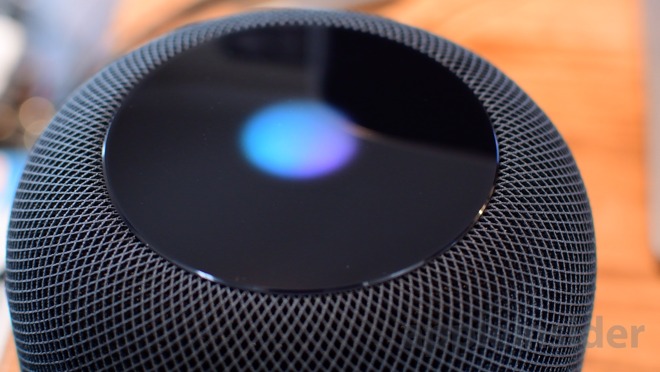
HomePod top panel
Apple's HomePod absolutely sounds better, though. Thanks to its own tuning and omnidirectional output, it fills a room with much better sound. The Symfonisk just isn't quite as powerful and doesn't have as much bass.
But that power has a downside. HomePod can be too punchy, especially at low volumes or while watching movies/TV. If the speaker is going to be used in a very small room or at low volumes, Symfonisk is the way to go.
If you are looking for a quieter speaker -- go Symfonisk. The Symfonisk Lamp is the best for surround speaker use, if you don't use Apple Music, or want to take advantage of the light.
HomePod is going to be king if you want a smart speaker that has a virtual assistant, you love Apple Music, or you want the best sound and don't mind the higher price.
Grab the Sonos and Ikea Symfonisk Lamp or bookshelf speaker direct from Ikea for $179 or $99 respectively. Grab the HomePod at a now cheaper $279 from B&H.
Stay on top of all Apple news right from your HomePod or HomePod mini. Say, "Hey, Siri, play AppleInsider Daily," and you'll get a fast update direct from the AppleInsider team.

Apple HomePod and the Ikea Symfonisk lamp speaker
Similarities
There are many commonalities between these two devices. They are both wi-fi speakers. And at first glance, the speaker parts look pretty similar.The body of the Ikea Symfonisk is just slightly larger before you get to the lamp and base. While the HomePod is smaller, it is also a dedicated device so the Symfonisk may be preferred as it can also replace a lamp at the same time.

AirPlay 2 works with both speakers
For Apple users, both devices rely heavily on AirPlay 2, natively support Apple Music, and can be configured in a stereo pair.
They also each can be automatically tuned to fit the space, though through different means. The HomePod uses an internal array of microphones and accelerometers to automatically tune itself whenever moved and the Symfonisk lamp uses Truetune from the Sonos app on an iPhone.
Neither work over Bluetooth.
HomePod
Apple's HomePod is a fantastic home speaker. It connects solely over Wi-Fi and streams Apple Music natively, but nothing else. Any other audio must be streamed using AirPlay 2.The HomePod is hefty and more compact than the Symfonisk Lamp, and sends audio out in all directions. The only physical controls are located on top in the form of a simple touch-sensitive screen.
There are microphones internally which are used not just for tuning, but for conversing with Siri and taking phone calls. If you are looking for a speaker with a virtual assistant, then this is your option as Symfonisk has no assistant whatsoever.
In the fall of 2019, iOS 13 and the updated HomePod software will bring even more features. That includes multi-user support for up to six people and Handoff support that allows phone calls and audio to instantly transfer between the HomePod and your phone with a tap.
Ikea Symfonisk Lamp
The Symfonisk Lamp has a lot going for it as well -- and not just the light that sits atop.
Ikea + Symfonisk lamp speaker
For privacy-minded individuals, the lack of any sort of microphone is a huge benefit. It also has an Ethernet port around back so it doesn't have to rely on the wireless network.

Ikea + Symfonisk lamp speaker control buttons
On the front are simple physical buttons that make the Symfonisk Lamp easy to control without a series of taps. Plus, instead of just acting as a stereo pair, Ikea's Symfonisk Lamp can also be configured to act as rear satellite surround speakers for any Sonos soundbar.

Ikea + Symfonisk lamp speaker supports many Sonos streaming services
The Symfonisk Lamp isn't limited to just AirPlay 2 and Apple Music. There are dozens of other sources that can be triggered by the Sonos app, and streamed natively by the speaker's hardware including Spotify, Pandora, Sirius XM, Tidal, and many more. If you don't use Apple Music, this is a huge benefit.
Audio quality
The Symfonisk Lamp is powered by Sonos and has much of the same acoustical properties as other Sonos speakers. It sounds great for its price point, hands down.
HomePod top panel
Apple's HomePod absolutely sounds better, though. Thanks to its own tuning and omnidirectional output, it fills a room with much better sound. The Symfonisk just isn't quite as powerful and doesn't have as much bass.
But that power has a downside. HomePod can be too punchy, especially at low volumes or while watching movies/TV. If the speaker is going to be used in a very small room or at low volumes, Symfonisk is the way to go.
Which to buy?
Choosing one over the other is a tough call unless you are looking for something specific -- then it's easy.If you are looking for a quieter speaker -- go Symfonisk. The Symfonisk Lamp is the best for surround speaker use, if you don't use Apple Music, or want to take advantage of the light.
HomePod is going to be king if you want a smart speaker that has a virtual assistant, you love Apple Music, or you want the best sound and don't mind the higher price.
Grab the Sonos and Ikea Symfonisk Lamp or bookshelf speaker direct from Ikea for $179 or $99 respectively. Grab the HomePod at a now cheaper $279 from B&H.
Stay on top of all Apple news right from your HomePod or HomePod mini. Say, "Hey, Siri, play AppleInsider Daily," and you'll get a fast update direct from the AppleInsider team.


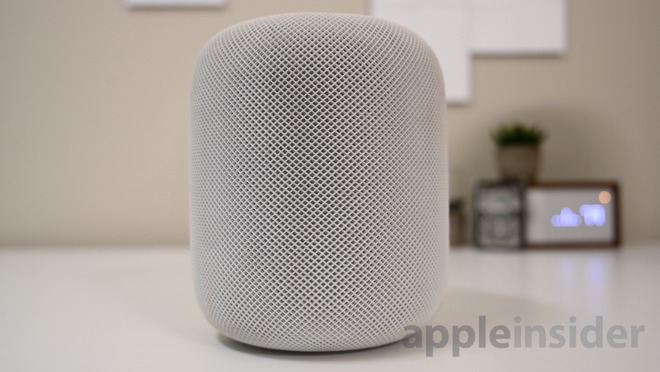
Comments
Personally, a microphone in the bedroom sounds like a terrible idea...
The HomePod really dominates in the living room and kitchen.
Looks unique!!
/s
Ikea has a target audience, it’s probably not people that can afford the HomePod...or male.
On topic: Nice comparison. Pretty much spot on. I think IKEA has a great idea with their speakers. Multi-functional: shelf or lamp. Reasonable price. Expandable. Ecosystem agnostic.
All my other light sources have been permanent fixtures (bathroom), in the ceiling... often attached to fans, etc.
If we were doing word associations: lamp = grandma
My mother also owned lamps... but she’s now a grandma ; )
A device which claims to be an audiophile grade speaker that only plays mp3 quality music and cannot accept other sources unless that source has AirPlay, which probably eliminates turntables for people who are vinyl purists, absolutely killed my interest in the device. I wanted something that could play the highest quality bit rate for digital and could play my high end vinyl collection as well.
“Mastered for iTunes is all about the quality of the source,” Apple says. “24-bit audio has a remarkably wide dynamic range which is preserved during encoding to AAC and these files are virtually indistinguishable from the original. Some of the best audio engineers in the business have a hard time telling them apart even on high-end audio equipment. Experts may be able to tell you that they are different in some subtle ways, but they can’t necessarily tell you which one they like better. This isn’t about AAC vs. CD or vinyl. It’s about creating the best possible master for the unique characteristics of each medium.”
Apple talks up its “powerful and practical software tools” designed for pro musicians.
“We want the music to sound as close as possible to the way it did in the studio or in the concert hall, preserving your vision and intention,” Apple says. “We want artists and sound engineers to be thoroughly satisfied and proud of the results they can now achieve in our format. So we have worked very hard to provide both the monitoring and quality assessment tools, plus an end-to-end mastering and encoding process that delivers the best possible audio for today’s digital world.”
You will hear people talk fondly of tube based systems sounding better (usually described as 'warmer') than a discrete based amplifier system. I won't argue with them, but I know I cannot hear the difference. I can hear the difference in AAC and either ALAC or FLAC. If you can't then don't buy a super high end system, you won't notice the improvement. But that doesn't mean that the improvement isn't there. But to me, even if it's all in my mind (another thing people will say when you bring up quality) and not reality, a high quality vinyl disc sounds better than the same album on a CD, and much much better than any streaming service, whether its Pandora, Spotify or Apple Music. I have heard of, but never personally listened to, Tidal music which is supposed to be (if you pay for the upper tier of their service) CD quality streaming music. I don't know if you can get Tidal on an iPhone or iPad but I know I can get it on my iMac, so I could stream it to an HomePod, but with the other physical and software limitations, which I think were artificial and not inherent in what Apple said they were trying to do, I'm not interested in going to the trouble.
Short version, it's not the price that is stopping me. Its the lack of versatility and limits that the device itself imposes on what it can accept. Sounding better than Alexa or Google Home is not hard. Even still, there are lots of people who say that either those speakers are good enough, or that they can't hear the difference between them and the HomePod. HomePod could have been a real, honest to goodness audiophile speaker. The hardware is 90% or more there. Offer a HomePod2 that will accept music from any wifi source, and charge $500 for each speaker. As I said, there isn't a lot you would need to change, hardware wise or system delivery wise with the current HomePod. Audiophiles would buy it. Non Audiophiles can't get beyond the current price anyway, or honestly don't hear the difference and shouldn't waste their money.
And no, I am not one of those referenced previously as it relates to a "dedicated listening room while enjoying a snifter of cognac".
It’s a $299.00 WiFi speaker that sounds great but to me doesn’t make sense to try and incorporate with an expensive turntable and vinyl collection. When you picture sitting back and critically listening to a high end vinyl collection doing it with the HomePod just doesn’t seem right to me.
All that said, once I’m done editing there isn’t a huge benefit to delivering a 16 bit per channel image to my clients. All that resolution is mostly wasted unless they plan to edit further.
Sure, the extra bits could theoretically improve rendering certain end uses, but it would be very subtle and wouldn’t hold a candle to the difference it makes when I’m trying to pull detail out of the darkest depths of the shadows in an image.
in audio, I suspect the reason musicians and recording technicians love high res audio is similar: they get much more latitude in editing.
All that said, I love high end audio and i’d happily buy new Sonos gear that could play it. I’m just not complaining that it’s not there now.